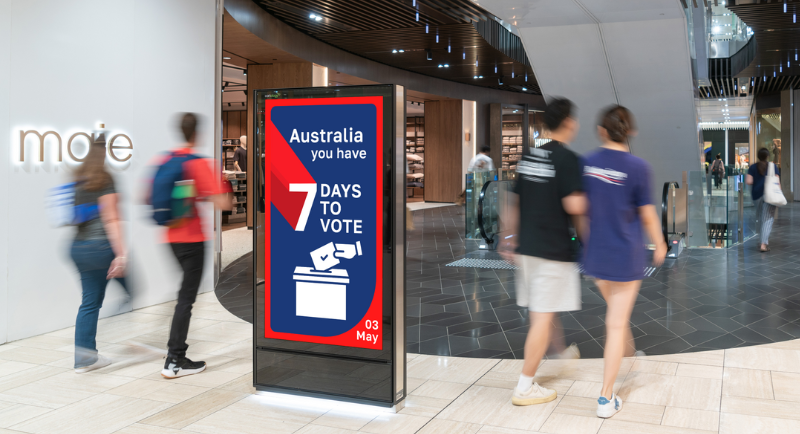By Ben Baker, Managing Director, APAC, Vistar Media
As Australia’s federal election is now in full swing, political strategists are re-evaluating their media mix in response to shifting public trust, increasing scrutiny of digital platforms, and the growing need for message clarity and control. Out-of-home (OOH) advertising has emerged as a channel that meets these demands, and is attracting increased investment from political campaigns.
Recent trends show that political advertisers are seeking trusted and impactful environments that can deliver broad reach without the risks often associated with digital media. OOH provides a brand-safe, highly visible space for political messages to land with authority and consistency. As concerns around misinformation, content adjacency and regulatory uncertainty continue to rise across digital platforms, OOH offers a clear and reliable alternative.
One of the medium’s key strengths lies in its clarity. Unlike online platforms, which are saturated with competing content, OOH delivers messages in focused, public environments with minimal distraction. There are no comment threads, autoplay videos or pop-up notifications vying for attention. This lack of clutter allows campaigns to present a single, uninterrupted message that stands on its own and resonates with viewers across repeated exposures.

Ben Baker
OOH placements are also highly visible and familiar. From billboards and bus shelters to digital screens in retail and community spaces, these formats are woven into the daily lives of voters. They are unskippable and unavoidable, providing consistent exposure to political messaging during commutes, errands and other everyday activities.
This environment of trust and clarity is particularly important in the context of political advertising. Meta’s recent decision to end third-party fact-checking on Facebook and Instagram highlights the uncertainty that continues to surround digital political ads. Campaigns must now navigate more carefully to avoid missteps or reputational risk.
Political spending is also on the rise. The federal government allocated 174 million dollars to advertising in 2023 to 2024, an increase of more than 30 percent from the previous year.
At the state level, Queensland reported a record spend of over 50 million dollars in the lead up to the upcoming election. With total political advertising spend forecast to exceed 200 million dollars in 2025, campaign strategists are now closely evaluating how to allocate budgets for maximum effectiveness. Out-of-home (OOH) advertising, and particularly programmatic digital out-of-home (DOOH), is becoming an increasingly strategic component of this mix, offering unmatched reach, flexibility, and contextual relevance at scale.
Modern OOH is also far more dynamic than in the past. Digital OOH (DOOH) networks allow for rapid message updates, location-based targeting and campaign optimisation informed by real-time audience data. This capability has allowed political campaigns to tailor messaging by electorate, respond quickly to breaking news and reinforce their narrative in line with key campaign moments.
Beyond campaigning, OOH plays a broader civic role – used to share accurate voting information, promote turnout and encourage civic engagement. In an era where misinformation can spread quickly online, having trusted physical channels to deliver verified information is more important than ever.
A successful political campaign requires a media strategy that delivers reach, credibility, and agility. OOH advertising offers all three, with the unique ability to cut through the noise and communicate with clarity and impact.
he platform also presents a significant opportunity for campaigns to influence swing electorates – areas where targeted messaging can make the difference between winning and losing. We are seeing campaign funds increasingly directed towards these key battlegrounds, as parties respond to polling data and focus their resources where they have the strongest chance of success. In this dynamic environment, OOH is set to become an essential tool for reaching voters in the moments – and places – that matter most.
